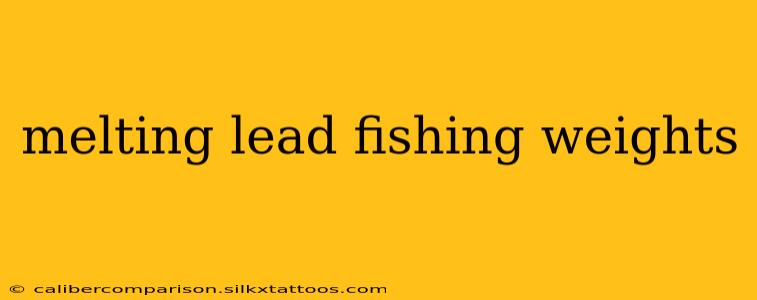Melting down lead fishing weights might seem like a simple task, but it's crucial to understand the safety hazards and ethical implications involved before you begin. This guide provides a comprehensive overview of the process, emphasizing safe practices and responsible disposal of lead.
Safety Precautions: Protecting Yourself from Lead Poisoning
Lead is a highly toxic heavy metal. Inhaling lead fumes or touching molten lead can lead to serious health problems, including lead poisoning. Never melt lead indoors. Always work in a well-ventilated outdoor area, far away from any living spaces or water sources.
Here's a breakdown of essential safety measures:
- Respiratory Protection: Wear a NIOSH-approved respirator specifically designed for lead dust and fumes. A simple dust mask is insufficient.
- Eye Protection: Use safety glasses or a face shield to protect your eyes from molten lead splashes and fumes.
- Skin Protection: Wear long sleeves, long pants, and heat-resistant gloves to prevent skin contact with molten lead.
- Ventilation: Ensure excellent airflow. A breeze is helpful, but a dedicated ventilation system is even better.
- Fire Safety: Keep a fire extinguisher nearby and know how to use it. Molten lead is extremely hot and can ignite flammable materials.
- First Aid: Have a first-aid kit readily available and know how to treat burns and handle potential lead exposure.
Methods for Melting Lead Fishing Weights
Several methods exist for melting lead fishing weights, each with its own advantages and disadvantages.
1. Using a Crucible and Heat Source
This is a common method requiring a crucible (a heat-resistant container), a heat source (such as a propane torch or a foundry furnace), and tongs for handling the hot crucible. Ensure the crucible is rated for lead melting temperatures. Gradually heat the lead, stirring occasionally to ensure even melting. Never overheat the lead.
2. Utilizing a Dedicated Lead Melting Furnace
For larger quantities or more frequent melting, a dedicated lead melting furnace is the safest and most efficient option. These furnaces are specifically designed to handle the high temperatures and fumes associated with lead melting. They often include safety features such as temperature controls and ventilation systems.
3. Improvised Methods (Not Recommended)
While some might consider using improvised methods like a campfire or a regular metal container, these are extremely dangerous and strongly discouraged. They lack the necessary safety features and control over temperature, significantly increasing the risk of accidents and lead exposure.
Ethical Considerations: Responsible Lead Disposal
After melting your lead weights, you're left with molten lead. Improper disposal can contaminate the environment and pose risks to wildlife and humans. Never pour molten lead directly into the ground or a drain.
Responsible disposal options include:
- Recycling: Contact local recycling centers or scrap metal dealers to inquire about lead recycling programs. Many facilities accept lead for recycling.
- Licensed Hazardous Waste Disposal: If recycling isn't an option, consult your local waste management authority for guidance on disposing of lead as hazardous waste.
Conclusion: Weighing the Risks and Benefits
Melting lead fishing weights requires careful planning and meticulous attention to safety. The risks associated with lead exposure are significant, and the ethical implications of improper disposal must be considered. By following these safety precautions and choosing responsible disposal methods, you can minimize the risks and ensure a safer and more environmentally friendly approach. Always prioritize safety and responsible environmental stewardship.

